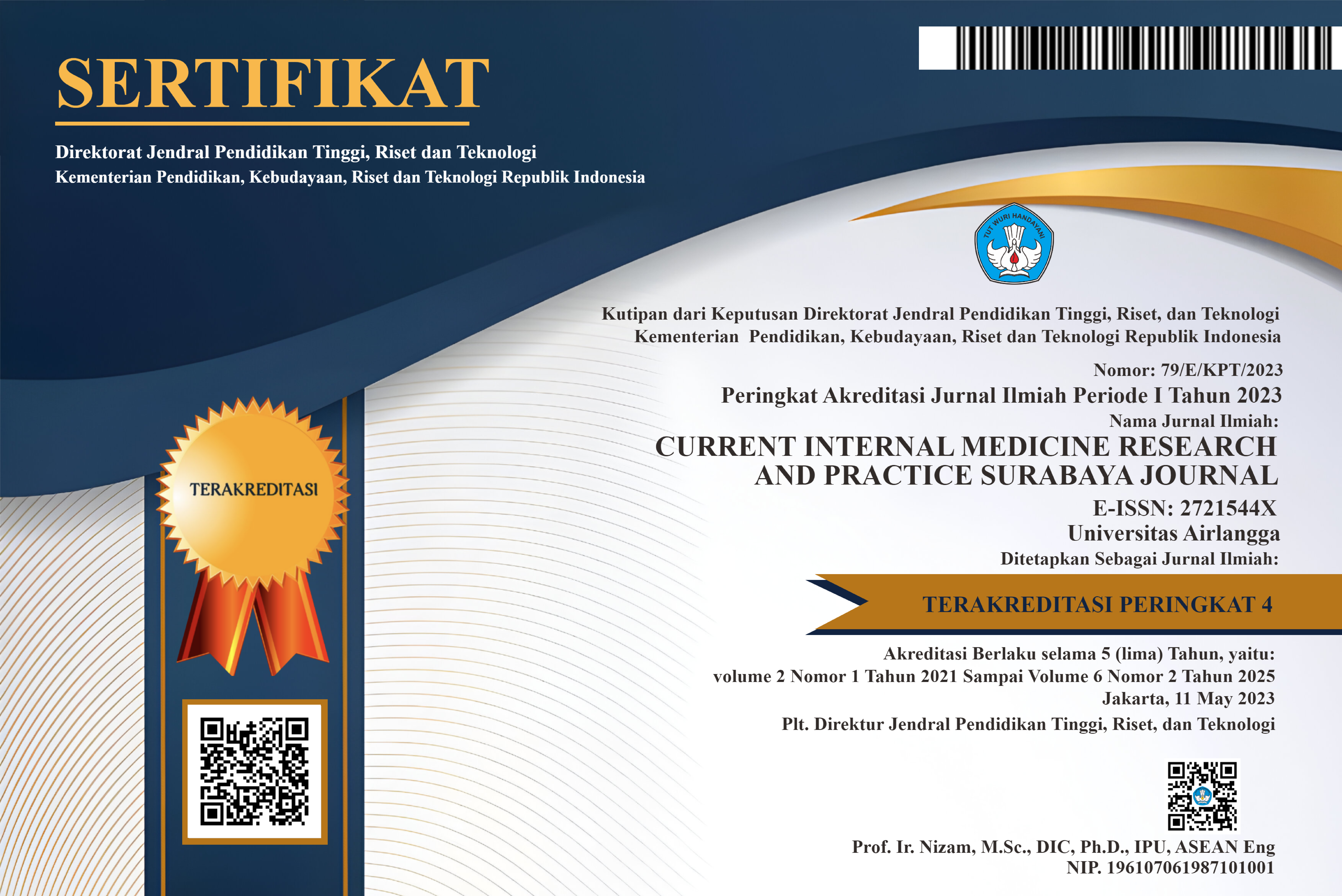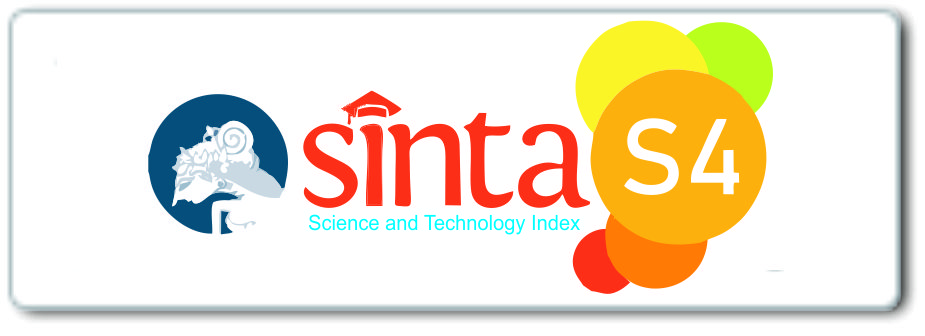In Silico Analysis Effect of Potential Antidiabetic from Dandang Gendis Extract on Aldose Reductase, Glucokinase, and GSK3β for Type 2 Diabetes Mellitus
Downloads
Introduction: Diabetes mellitus is a metabolic disease characterized by hyperglycemia. Various epidemiological studies have shown a trend of increasing incidence and prevalence of diabetes mellitus in various parts of the world. Therefore, diabetes mellitus is currently a global health threat. Dandang gendis (Clinacanthus nutans) is a widely used plant as a traditional herbal treatment in Indonesia, and it has been proven that the ethanol extract of dandang gendis leaves shows an antidiabetic effect. This research aims to determine the compatibility among the flavonoid compounds in C. nutans with Aldose reductase, glucokinase, and GSK3β target drugs for type 2 diabetes mellitus using in silico method.
Methods: 45 compounds were obtained from multiple sources. The screening method used Lipinski's rule of five and Pyrx until 8 compounds were selected. Avogadro, AutoDock 4.2, and Biovia Discovery Studio 2016 were used for molecular docking and visualization analysis.
Results: Molecular docking results demonstrate that the ligand-protein interaction's binding energy was -7.31 to 35.25 kcal/mol for 1AH3, -7.55 to 0.15 kcal/mol for 1V4S, and -7.99 to -2.85 kcal/mol for 3D0E.
Conclusion: We can conclude that flavonoid compounds Apigenin, Vitexin, 3,3-di-O-Methylellagic Acid, and Clinacoside C show a high binding affinity with Aldose Reductase, Glucokinase, and GSK3β proteins and have the potential to be oral antidiabetic drug compounds for Diabetes Mellitus. However, its binding affinity has not been able to exceed that of the native ligand of the protein. Further research is needed to determine the significant efficacy and potential as an antidiabetic.
Abdullah N and Kasim K. 2017. In-vitro antidiabetic activity of Clinacanthus nutans extracts. International Journal of Pharmacognosy and Phytochemical Research 9(6):846–852. DOI: 10.25258/phyto.v9i6.8189.
Alam A, Ferdosh S, Ghafoor K, et al. 2016. Clinacanthus nutans: a review of the medicinal uses, pharmacology and phytochemistry. Asian Pacific Journal of Tropical Medicine 9(4): 402–409. DOI: 10.1016/j.apjtm.2016.03.011.
Azemi AK, Mokhtar SS, Rasool AHG. 2020. Clinacanthus nutans: Its potential against diabetic vascular diseases. Brazilian Journal of Pharmaceutical Sciences 56. DOI: 10.1590/S2175-97902020000118838.
Bai N, He K, Roller M, et al. 2008. Active compounds from Lagerstroemia speciosa, insulin-like glucose uptake-stimulatory/inhibitory and adipocyte differentiation-inhibitory activities in 3T3-L1 cells. Journal of Agricultural and Food Chemistry 56(24):11668–11674. DOI: 10.1021/JF802152Z.
Bhikshapathi DVRN, Kumar YS, Rao YM, et al. 2010. Borrelidin: a prospective drug. Indian Journal of Biotechnology 9(1):18–23.
Decroli E. 2019. Diabetes Melitus Tipe 2, 1st eds. Ed: Kam A, Efendi YP, Decroli GP, Rahmadi A. Padang, Pusat Penerbitan Bagian Ilmu Penyakit Dalam Fakultas Kedokteran Universitas Andalas. Available at http://repo.unand.ac.id/21867/1/Buku%20Diabetes%20Melitus%20%28Lengkap%29.pdf
Dewinta NR, Mukono IS, Mustika A. 2020. Pengaruh pemberian ekstrak dandang gendis (Clinacanthus nutans) terhadap kadar glukosa darah pada tikus wistar model diabetes melitus. Jurnal Medik Veteriner 3(1):76-81. DOI: 10.20473/jmv.vol3.iss1.2020.76-81.
Ginwala R, Bhavsar R, Chigbu DI, et al. 2019. Potential role of flavonoids in treating chronic inflammatory diseases with a special focus on the anti-inflammatory activity of apigenin. Antioxidants 8(2):35 DOI: 10.3390/antiox8020035.
Hariftyani AS, Kurniawati LA, Khaerunnisa S, et al. 2021. In silico analysis of potential antidiabetic phytochemicals from Matricaria chamomilla l. Against ptp1b and aldose reductase for type 2 diabetes mellitus and its complications. Natural Product Sciences 27(2):99–114. DOI: 10.20307/nps.2021.27.2.99.
International Diabetes Federation. 2017. IDF Diabetes Atlas, 10th ed. Available at www.diabetesatlas.org.
Josten S, Mutmainah, Hardjoeno. 2006. Lipid profile in type 2 diabetic mellitus patient's. Indonesian Journal of Clinical Pathology and Medical Laboratory 13(1):20-22. DOI: http://dx.doi.org/10.24293/ijcpml.v13i1.894.
Khaerunnisa S, Kurniawan H, Awaluddin R, et al. 2020. Potential inhibitor of COVID-19 Madeswaran A, Umamaheswari M, Kuppusamy A, et al. 2012. Discovery of potential aldose reductase inhibitors using in silico docking studies. Oriental Pharmacy and Experimental Medicine 12(2):157–161. DOI: 10.1007/s13596-012-0065-3.
Khaerunnisa S, Suhartati, Awaluddin, R. 2020. Penelitian In Silico untuk Pemula. Surabaya, Airlangga University Press.
Kooti W, Moradi M, Akbari SA, et al. 2015. Therapeutic and pharmacological potential of Foeniculum vulgare Mill: A review. Journal of HerbMed Pharmacology 4(1):1–9.
Main protease (Mpro) from several medicinal plant compounds by molecular docking study. Preprints. doi: 10.20944/preprints202003.0226.v1.
Matschinsky FM, Zelent B, Doliba N, et al. 2011. Glucokinase activators for diabetes therapy: May 2010 status report. Diabetes Care 34(Suppl 2):S236-S243. DOI: 10.2337/dc11-s236.
Nurdiana S, Goh YM, Ahmad H, et al. 2017. Changes in pancreatic histology, insulin secretion and oxidative status in diabetic rats following treatment with Ficus deltoidea and vitexin. BMC Complementary and Alternative Medicine 17. DOI: 10.1186/S12906-017-1762-8.
Panda S and Kar A. 2007. Apigenin (4',5,7-trihydroxyflavone) regulates hyperglycaemia, thyroid dysfunction and lipid peroxidation in alloxan-induced diabetic mice. J Pharm Pharmacol 59(11):1543–1548. DOI: 10.1211/jpp.59.11.0012.
Peng XF, Zheng ZP, Cheng KW, et al. (2008). Inhibitory effect of mung bean extract and its constituents vitexin and isovitexin on the formation of advanced glycation endproducts. Food Chemistry 106(2):475-481.
Samy BG and Xavier L. 2015. Molecular docking studies on antiviral drugs for SARS. International Journal of Advanced Research in Computer Science and Software Engineering 5(3):75–79.
Sifuentes-Franco S, Pacheco-Moisés FP, Rodríguez-Carrizalez AD, et al. 2017. The role of oxidative stress, mitochondrial function, and autophagy in diabetic polyneuropathy. Journal of Diabetes Research 2017. DOI: 10.1155/2017/1673081.
Tabopda TK, Ngoupayo J, Liu J, et al. 2008. Alpha-glucosidase inhibitors ellagic acid derivatives with immunoinhibitory properties from Terminalia superba. Chem Pharm Bull 56(6):847-850. DOI: 10.1248/cpb.56.847.
Tang WH, Martin KA, Hwa J. 2012. Aldose reductase, oxidative stress, and diabetic mellitus. Frontiers in Pharmacology 9. DOI: 10.3389/fphar.2012.00087.
The Indonesian Society of Endocrinology. 2021. Pedoman Pengelolaan dan Pencegahan Diabetes Melitus Tipe 2 di Indonesia. Available at https://pbperkeni.or.id/wp-content/uploads/2021/11/22-10-21-Website-Pedoman-Pengelolaan-dan-Pencegahan-DMT2-Ebook.pdf. Accessed 4 January 2022.
Vinayagam R and Xu B. 2015. Antidiabetic properties of dietary flavonoids: a cellular mechanism review. Nutrition & Metabolism 12. DOI: 10.1186/s12986-015-0057-7.
Wang F, Yin J, Ma Y, et al. 2017. Vitexin alleviates lipopolysaccharide-induced islet cell injury by inhibiting HMGB1 release. Molecular Medicine Reports 15(3):1079–1086. DOI: 10.3892/MMR.2017.6114.
Zhang Y, Huang N, Yan F, et al. 2018. Diabetes mellitus and Alzheimer's disease: GSK-3β as a potential link. Behavioural Brain Research 339:57–65. DOI: 10.1016/J.BBR.2017.11.015.
Copyright (c) 2023 Safira Raissa Dwi Putri, Irda Bella, Siti Khaerunnisa, Nurlaili Susanti, Arifa Mustika

This work is licensed under a Creative Commons Attribution-ShareAlike 4.0 International License.
Copyright (c) Author
1. The journal allows the author to hold the copyright of the article without restrictions.
2. The journal allows the author(s) to retain publishing rights without restrictions.
3. The formal legal aspect of journal publication accessibility refers to Creative Commons Atribution-Share Alike 4.0 (CC BY-SA).






















